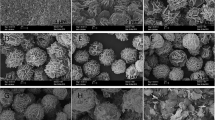Abstract
Polyhydroquinone (PHQ) is a redox-active polymer with quinone/hydroquinone redox active units in the main chain and may have potential applications as a mediator in biosensors and biofuel cells. By the oxidative polymerization of hydroquinone (HQ), PHQ can be easily synthesized, but the reaction lacks control over the structure of the product. Deoxycholic acid (DCA) was introduced as a supramolecular template to control the reaction. The reaction rate is 14 times of that in deionized water and twice of that in buffer. The DCA template increases not only the reaction rate, but also the molecular weight of the polymer obtained. The template effect of DCA was attributed to the supramolecular assemblies of DCA formed in the solution. Cyclic voltammetry study indicated the resulting PHQ was redox-active. While the supramolecular assemblies of DCA provided a template for the oxidative polymerization of HQ, the protons released as a by-product of the oxidative polymerization of HQ in turn enhanced the self-assembly of DCA. As a result, DCA microfibers form and separate out of the solution.
Similar content being viewed by others
References
Moulay S. Polymers with dihydroxy/dialkoxybenzene moieties. ComptesRendusChimie, 2009, 12(5): 577–601
Saad M. Dihydroxybenzene/benzoquinone-containing polymers: Organic redox polymers. ActualiteChimique, 2000, (7–8): 12–27
Wang P, Martin BD, Parida S, Rethwisch DG, Dordick JS. Multienzymic synthesis of poly(hydroquinone) for use as a redox polymer. J Am Chem Soc, 1995, 117(51): 12885–12886
Zhang AJ, Zhang WJ, Zhang YJ, Guan Y. Progress on synthesis and application of redox poly (hydroquinone). Polym Bull, 2011, (5): 17–26
Furlani A, Russo MV, Cataldo F. Oxidative polymerization of p-benzoquinone and hydroquinone. Conductivity of doped and undoped polymerization products. Synthetic Metals, 1989, 29(1): 507–510
Sadykh-Zade SI, Ragimov AV, Suleimanova SS, Liogonkii VI. The polymerization of quinones in an alkaline medium and the structure of the resulting polymers. Polymer Science USSR, 1972, 14(6): 1395–1403
Yamamoto K, Asada T, Nishide H, Tsuchida E. The Preparation of poly(dihydroxyphenylene) through the electro-oxidative polymerization of hydroquinone. Bull Chem Soc Jpn, 1990, 63(4): 1211–1216
Yamamoto T, Kimura T. Preparation of pi-conjugated poly (hydroquinone-2, 5-diyl) and poly (p-benzoquinone-2,5-diyl) and their electrochemical behavior. Macromolecules, 1998, 31(8): 2683–2685
He J, Zhang AJ, Zhang YJ, Guan Y. Novel redox hydrogel by in situ gelation of chitosan as a result of template oxidative polymerization of hydroquinone. Macromolecules, 2011, 44(7): 2245–2252
Polowinski S. Template polymerisation and co-polymerisation. Progress in Polymer Science, 2002, 27(3): 537–577
Ramanathan N, Currie AL, Colvin R. Formation of helical microfibrils from a steroid acid complex. Nature, 1961, 190: 779–781
Blow DM, Rich A. Studies on the formation of helical deoxycholate complexes. J Am Chem Soc, 1960, 82(14): 3566–3571
Rich A, Blow DM. Formation of a helical steroid complex. Nature, 1958, 192: 423–426
Zhu XX, Nichifor M. Polymeric materials containing bile acids. Acc Chem Res, 2002, 35(7): 539–546
Sobotka H, Czeczowiczka N. The gelation of bile salt solutions. J Colloid Science, 1958, 13(2): 188–191
Cataldo F. On the structure of macro molecules obtained by oxidative polymerization of polyhydroxyphenols and quinines. Polymer International, 1998, 46(4): 263–268
Yamamoto K, Asada T, Nishide H, Tsuchida E. Preparation of electroactive poly(dihydroxyphenylene). Chemistry Lett, 1989, 18(1): 65–68
Nakano K, Hirayama G, Toguchi M, Nakamura K, Iwamoto K, Soh N, Imato T. Poly(hydroquinone)-coated electrode for immobilizing of 5′-amine functioned capture probe DNA and electrochemical response to DNA hybridization. Sci Technol Adv Mater, 2006, 7(7): 718–725
Author information
Authors and Affiliations
Corresponding authors
Rights and permissions
About this article
Cite this article
Zhang, A., He, J., Guan, Y. et al. Oxidative polymerization of hydroquinone using deoxycholic acid supramolecular template. Sci. China Chem. 55, 830–835 (2012). https://doi.org/10.1007/s11426-012-4504-2
Received:
Accepted:
Published:
Issue Date:
DOI: https://doi.org/10.1007/s11426-012-4504-2




